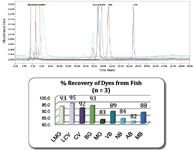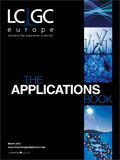Determination of Dyes in Fish Tissue by HPLC/UV
The Application Notebook
UCT Application Note
Daniel A. Fonseca, Brian Kinsella, Thomas August and Craig A. Perman, UCT, LLC, Bristol, USA.
Various triarylmethane and fluorescent dyes are used in aquaculture as antibacterial, antifungal and anthelmintic agents for the treatment of fish disease. The US Foods and Drug Administration (FDA) has banned the importation of certain fish from several countries due to possible contamination of these food products. Most published methods only detect malachite green, crystal violet and their metabolites. UCT has developed a procedure for the extraction and analysis of nine dyes used in aquaculture using a carboxylic acid ion-exchange SPE cartridge.
1) Sample Preparation
a. Prepare tilapia fish tissue (purchased at a local grocery store) by homogenization with dry ice.
b. Add 100 µL of each dye standard (50 µg/mL) to one gram of fish tissue.
c. Vortex for 30 s.
d. Add 10 mL of acetonitrile/100 mM ammonium acetate buffer at pH 3 (90:10, v/v).
e. Vortex for 30 s.
f. Centrifuge at 4500 rpm for 5 min and use the supernatant for analysis.
g. Add 10 mL of 100 mM phosphate buffer (pH 7.0) to the supernatant (1:1 dilution).
h. Prepare the vacuum manifold or automated SPE system using EUCCX156 cartridge(s).

Dyes included in the study
2) Condition Cartridges (no vacuum used)
a. Add 3 mL of methanol to each cartridge.
b. Add 3 mL of reagent grade water to each cartridge.
c. Add 1 mL of 100 mM phosphate buffer (pH 7.0).
3) Extract Sample (no vacuum used)
a. Extract sample using 1–2 mL/min flow-rate.
4) Wash Cartridge
a. Add 3 mL of 100 mM phosphate buffer solution to cartridge.
b. Slowly draw through.
c. Dry cartridge for 10–15 min at full vacuum.

Chromatography
5) Elute Dye Analytes
a. Add 3 mL of (95:5) methanol/acetic acid solution (adjusted to pH 2.5).
b. Collect eluate using 1–2 mL/min flow rate.
c. Evaporate eluate to dryness under N2 at < 40 °C.
d. Redissolve residue using 500 µL of methanol:H2O (50:50, v/v).
LC/UV Analysis
Instruments
Waters 1525 Binary HPLC Pump, 717plus autosampler and 487 UV Detector (other instrumentation may be used)
LC/UV Parameters
Column: Selectra C18, 150 × 2.1 mm, 3 µm particle size (or equivalent)
Injection: 20 µL
Oven temp: 20 °C
Data mode: Dual absorbance: 265 and 600 nm
Pump mode: Gradient
Mobile Phase:
(A) Deionized (DI) H20 with 10 mM ammonium acetate and 5 mM octanesulfonic acid
(B) Methanol with 10 mM ammonium acetate and 5 mM octanesulfonic acid
Conclusion
Water soluble dyes used in fish aquaculture can be readily analysed with good recovery using UCT's EUCCX156 carboxylic acid cation exchange SPE cartridge. No oxidation to the leuco metabolites is required prior to LC/UV detection. An LC/MS/MS method is being developed to detect the dyes at lower concentrations according to FDA and EU criteria and will be published shortly.
UCT, LLC
2731 Bartram Road, Bristol, Pennsylvania, USA
Tel: 800.385.3153
Email: methods@unitedchem.com
Website: www.unitedchem.com

New TRC Facility Accelerates Innovation and Delivery
April 25th 2025We’ve expanded our capabilities with a state-of-the-art, 200,000 sq ft TRC facility in Toronto, completed in 2024 and staffed by over 100 PhD- and MSc-level scientists. This investment enables the development of more innovative compounds, a broader catalogue and custom offering, and streamlined operations for faster delivery. • Our extensive range of over 100,000 high-quality research chemicals—including APIs, metabolites, and impurities in both native and stable isotope-labelled forms—provides essential tools for uncovering molecular disease mechanisms and exploring new opportunities for therapeutic intervention.
New Guide: Characterising Impurity Standards – What Defines “Good Enough?”
April 25th 2025Impurity reference standards (IRSs) are essential for accurately identifying and quantifying impurities in pharmaceutical development and manufacturing. Yet, with limited regulatory guidance on how much characterisation is truly required for different applications, selecting the right standard can be challenging. To help, LGC has developed a new interactive multimedia guide, packed with expert insights to support your decision-making and give you greater confidence when choosing the right IRS for your specific needs.

.png&w=3840&q=75)

.png&w=3840&q=75)



.png&w=3840&q=75)



.png&w=3840&q=75)



















